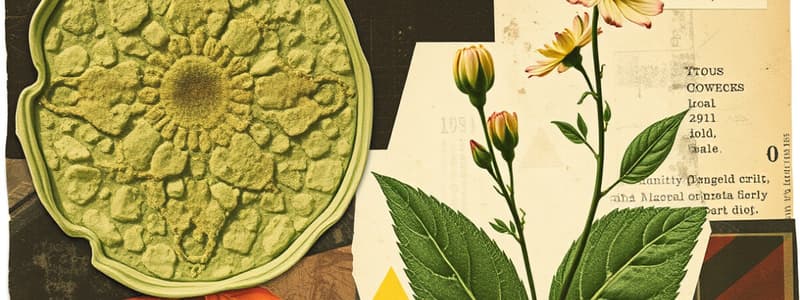Podcast
Questions and Answers
What is the primary characteristic of parenchyma cells?
What is the primary characteristic of parenchyma cells?
- They have only thin primary walls. (correct)
- They are exclusively found in woody plants.
- They are metabolically inactive.
- They have thick secondary walls.
Which of the following is NOT a type of specialized parenchyma cell?
Which of the following is NOT a type of specialized parenchyma cell?
- Chlorenchyma
- Transfer cells
- Glandular parenchyma
- Sclerenchyma (correct)
Which group of flowering plants is classified under the Division Magnoliophyta?
Which group of flowering plants is classified under the Division Magnoliophyta?
- Mosses
- Eudicots (correct)
- Gymnosperms
- Fern
What type of plant body does a herbaceous plant have?
What type of plant body does a herbaceous plant have?
What is the main function of glandular parenchyma cells?
What is the main function of glandular parenchyma cells?
Which of the following describes chlorenchyma?
Which of the following describes chlorenchyma?
What do the terms monocots and eudicots refer to?
What do the terms monocots and eudicots refer to?
Which characteristic is NOT common among all flowering plants?
Which characteristic is NOT common among all flowering plants?
What is the main function of parenchyma cells in plants?
What is the main function of parenchyma cells in plants?
Which statement correctly describes collenchyma cells?
Which statement correctly describes collenchyma cells?
What characteristic distinguishes sclerenchyma cells from collenchyma and parenchyma?
What characteristic distinguishes sclerenchyma cells from collenchyma and parenchyma?
In which type of phyllotaxy are leaves arranged in four rows when viewed from above?
In which type of phyllotaxy are leaves arranged in four rows when viewed from above?
What role do plasmodesmata-rich areas play in sclerenchyma cells?
What role do plasmodesmata-rich areas play in sclerenchyma cells?
Which type of cells primarily support the plant structure through strength?
Which type of cells primarily support the plant structure through strength?
What happens to axillary buds if the apical meristem is healthy?
What happens to axillary buds if the apical meristem is healthy?
What is a common characteristic of the secondary walls in sclerenchyma cells?
What is a common characteristic of the secondary walls in sclerenchyma cells?
Flashcards are hidden until you start studying
Study Notes
Plant Evolution and Structure
- Plants transitioned to terrestrial life approximately 420 million years ago, leading to specialized tissues and organs.
- All flowering plants (angiosperms) possess leaves, stems, and roots, which may be modified for various functions.
- No plant species has entirely lost the evolutionary presence of roots, stems, or leaves.
- Flowering plants are categorized under the Division Magnoliophyta, with key groups including basal angiosperms, eudicots, and monocots.
- Plant bodies can be classified as primary (herbaceous) or secondary (woody).
Basic Cell Types and Tissues
-
Parenchyma
- Composed of cells with thin primary walls; metabolically active and mostly alive at maturity.
- Forms a mass known as parenchyma tissue, crucial for storage and metabolic functions.
-
Chlorenchyma
- A type of parenchyma involved in photosynthesis, characterized by light-permeable thin walls allowing CO2 and light access to chloroplasts.
-
Glandular Parenchyma
- Specialized cells that secrete substances such as nectar, fragrances, mucilage, resins, and oils.
-
Transfer Cells
- Facilitate short-distance transport of materials through large plasma membranes equipped with molecular pumps.
-
Phloem Parenchyma
- Stores nutrients and is metabolically less expensive to build because of thin walls.
-
Collenchyma
- Consists of cells with both thin and thickened primary walls, providing support and plasticity, commonly found beneath the epidermis or supporting vascular bundles.
-
Sclerenchyma
- Features thick, lignified secondary walls, typically dead at maturity, providing structural support. It includes:
- Conductive Sclerenchyma (tracheary elements like tracheids and vessel elements) for water transport.
- Mechanical Sclerenchyma (fibers and sclereids) for additional support.
Stem Structure and Organization
-
Phyllotaxy: The arrangement of leaves on the stem.
- Types:
- Alternate: One leaf per node.
- Opposite: Two leaves per node.
- Whorled: Three or more leaves per node.
- Types:
-
Orientation variations of phyllotaxy include:
- Distichous: Two rows of leaves.
- Decussate: Four rows of leaves.
- Spiral: Leaves arranged spirally along the stem.
Bud Development
- Each leaf axil contains a bud; however, many remain dormant.
- The apical meristem's health is crucial; if it is damaged, dormant axillary buds become active and can develop branches.
Studying That Suits You
Use AI to generate personalized quizzes and flashcards to suit your learning preferences.



